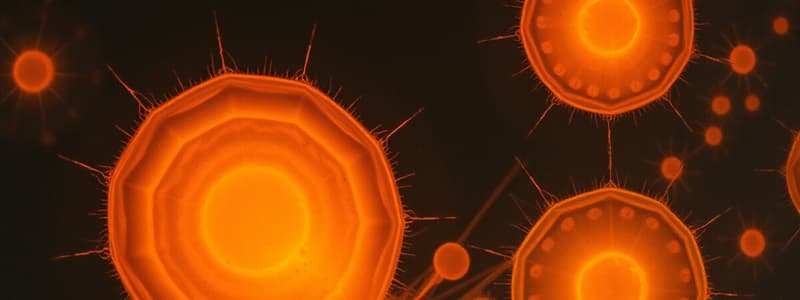Podcast
Questions and Answers
What are prokaryotes?
What are prokaryotes?
Cells that evolved prior to the formation of a nucleus, typically small and simple.
What structures do prokaryotes use to help move and cling to surfaces?
What structures do prokaryotes use to help move and cling to surfaces?
Pili and fimbriae.
What is the function of mesosomes in prokaryotes?
What is the function of mesosomes in prokaryotes?
They function for aerobic respiration and cell wall formation.
Eukaryotes contain a cytoskeleton.
Eukaryotes contain a cytoskeleton.
Which of the following is NOT a benefit of prokaryotic organisms?
Which of the following is NOT a benefit of prokaryotic organisms?
What is bioremediation?
What is bioremediation?
How do bacteria assist in waste disposal?
How do bacteria assist in waste disposal?
Which bacterium is known for leaching copper from mining leftovers?
Which bacterium is known for leaching copper from mining leftovers?
What is Bacillus thuringiensis used for?
What is Bacillus thuringiensis used for?
Prokaryotes play important roles in __________ cycles.
Prokaryotes play important roles in __________ cycles.
Flashcards are hidden until you start studying
Study Notes
Prokaryotes
- Evolved before the formation of a nucleus.
- Typically small and simple in structure, facilitating easy transport of dissolved substances.
- Feature pili (singular: pilus) for movement and adherence to surfaces.
- Contain mesosomes, which are involved in aerobic respiration and cell wall formation.
- Possess a glycocalyx (capsule or slime layer) that helps some bacteria evade phagocytosis by white blood cells.
- Have fimbriae that enable attachment to host cells or substrates.
- Can form endospores, allowing them to create dormant, highly resistant cells.
- Lack a cytoskeleton.
Eukaryotes
- Contain a nucleus that safeguards and regulates access to cellular DNA.
- Usually larger and more complex than prokaryotes.
- Feature membrane-bound organelles.
- Possess a cytoskeleton, providing structural support.
Benefits of Prokaryotic and Eukaryotic Organisms
-
Food Production:
- Bacteria like Lactobacillus and various yeasts and molds have a longstanding role in the fermentation of foods such as cheese, pickles, soy sauce, vinegar, wine, beer, and yogurt.
-
Pollution Clean-Up:
- Bioremediation utilizes microorganisms, fungi, and plants to detoxify contaminated environments, including the use of bacteria that digest hydrocarbons in oil spills.
-
Biomining:
- Prokaryotes are leveraged to extract minerals from ores, such as the bacterium Thiobacillus ferooxidans, which enhances copper recovery from mining waste while reducing costs.
-
Waste Disposal and Biogas Production:
- Bacteria decompose sewage waste through aerobic and anaerobic processes, converting organic matter into harmless sludge, and generating methane gas as an energy source for electricity, heating, or vehicle fuel.
-
Agricultural Uses:
- Prokaryotes play vital roles in biogeochemical cycles (like nitrogen, carbon, and phosphorus), facilitating nutrient movement through ecosystems.
-
Pest Control:
- Bacillus thuringiensis, a Gram-positive bacteria, produces a toxin (Bt toxin) that is effective against specific pests like mosquitoes and caterpillars, without harming humans or beneficial insects.
Studying That Suits You
Use AI to generate personalized quizzes and flashcards to suit your learning preferences.




